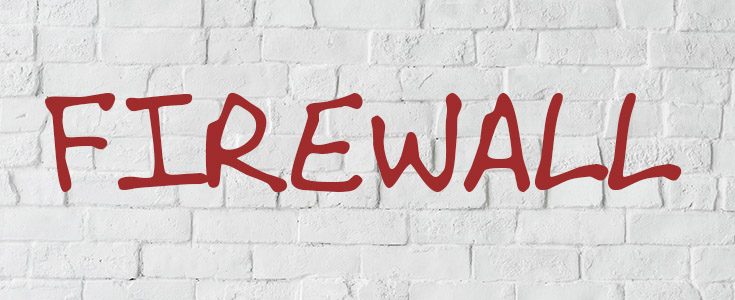With cyber attacks on the rise, proper firewall configuration is more important now than ever before. As most breaches are the result of configuration errors, your firewall is essential to keep your information safe. Whether it’s for a business or residences, balancing security with optimized performance is a difficult task for security professionals.
While many network security professionals focus on identifying and fixing vulnerabilities, the true focus should be on the firewall’s configuration. A misconfigured firewall not only leaves your data susceptible to attack, but it can also damage your business in many other ways. Here are some of the most common firewall configuration errors and how to avoid them.
Lack of Firewall Rules
The most common firewall configuration that leaves systems at risk is neglecting to set up initial firewall rules. When firewalls are initially set up, they are often left in an ‘any to any’ status, meaning traffic can come from and go to any destination. This open traffic renders a firewall useless. When new firewalls are set up, security teams often leave firewall access open as they determine the needs of the system and the users.
Where networks become vulnerable is when the ‘any to any’ traffic isn’t restricted by firewall rules. It’s common to see this open traffic and no defined rules as other tasks become a priority for IT and security teams.
Rather than working from a broad to a defined firewall and risking vulnerability, firewalls should only allow the minimum access needed by each user. It’s easy to expand firewall rules to provide additional access; it’s much harder to come back from a security breach.
Not Updating Rules Consistently
Once rules are defined and set, it doesn’t mean that your firewall doesn’t need to be monitored and updated regularly. As your business network grows and changes, so should your firewall. With every new device and every new user, your IT team should be reviewing your firewall and making updates accordingly.
Rules will need to be added, modified, or removed to adapt to your needs. Technologies develop, roles change, and users join and leave the network, meaning your firewall needs to be examined and updated to meet those needs.
You may notice that rules begin to overlap, with multiple rules serving the same or similar function in your firewall. Reviewing your rules for duplicates and deleting those duplicate rules speeds up your network. Network performance is important, and firewall rules have a direct impact on that performance. Removing unnecessary rules makes your network run more efficiently.
Taking a proactive approach to your firewall management will keep your team running efficiently. Rather than waiting for something to break before fixing it, anticipate any firewall needs before they happen. An easy way to stay ahead of those changes is to set up quarterly firewall reviews, even during times when your network isn’t going through drastic change.
Manual Updates vs Automation
Automation makes firewall setup and updates simple and effective. Rather than manually setting up your firewall and manually updating settings and firewall rules, you can set automation protocols to do the work for you. This creates a consistent firewall and implementation experience and allows you to set specific processes and guidelines that will be followed every time.
As most breaches and attacks are due to misconfiguration, automation can reduce configuration errors, leaving your network more secure than it may be with manual updates. You can even integrate that automation into other areas of your network, which can optimize your network and create a better network experience for everyone involved.
Issues with Security Logging
Security logs detail the incoming and outgoing web traffic on your network. One of the biggest mistakes that you can make with your firewall is not regularly checking and reviewing the security logs. These logs can show you any issues with your security and can also detail any changes that may have been made to your firewall settings.
Apart from analyzing traffic and assessing risk in your firewall, logs will also show you which rules are being utilized the most and which ones you might be able to remove. Removing rules can help optimize your firewall and network performance, which is critical for efficiencies.
Finally, your logs will provide vital information if you do experience a breach or a cyber attack. After a breach, your logs will be able to tell you how the breach happened and can show you what needs to happen to prevent future attacks. This traceability is important for your investigation. Being attacked without a way to trace the attack and secure your network means your system may be vulnerable to another attack in the future.
Inconsistent Authentication Requirements
Authentication is another major firewall configuration issue. If you have a network that spans multiple sites, it’s important to have consistent authentication standards across your business. When authentication standards are mismatched, with one authentication being weaker than another, the weaker authentication is much more susceptible to attack.
For example, multiple sites may use various router configurations that don’t match authentication standards. This leaves the network vulnerable to attack through the routers that do not align with the centralized authentication mechanism.
Authentication mechanisms are the backbone of your information security. Choosing an authentication mechanism that meets corporate authentication standards creates consistency across your network, meaning there are no vulnerable areas in your network and firewall.
Conclusion
Your firewall is the most important security feature in your network, so it’s important to make sure that your firewall is configured correctly to keep your data safe. Human error is the leading cause of security breaches, and your firewall is your primary defense against cyber attacks.
While firewall configuration issues are serious, they’re also easy to fix. These are some of the top firewall misconfiguration errors that severely impact business information security. By taking the time to examine these errors and how they can be resolved, you can improve your security and reduce your chances of a security breach.



